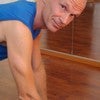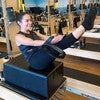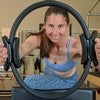Description
This is special footage that was created by Fran Hoyte and Joseph DeRuvo Jr, who generously donated it to the Pilates Legacy Project.
About This Video
Transcript
Read Full Transcript
We are in the woods of Connecticut and we're at Mary Bowen's Pilates studio and her home. Hi, I'm Fran Hoyt and this is another studio tour for Pilates Any Time, East Coast. Should we go in and see if Mary's home?
How are you? I'm good. It's so good to see you. Come on, come on. Come on Fiona.
Even the dog barking, very natural. It's good to see you. Good to see you. Good to see you. Thanks for having us, Mary. Well I'm happy to have you.
How long have you lived here? 1963. '63. 58 years I think that is. And how old is the house?
1810. Your studio full of Packer Sandra, like the motive Packer Sandra. How did this come about? There was a narrow strip and mostly lawn. And through the years, the Packer Sandra just decided to make itself more important.
And it's, I love the sweep of it. I love the curves of it. It's so great. There's, you go ahead. Going in.
Me? You go ahead. Yeah, you go ahead. Okay, thanks Mary. I love this space.
Six and a half years with, by twice weekly sessions with Joe and Clara Pilates. Yes, that is 1959. At age, starting with 29. To just in 1966, just before he died. And then subsequent to that, Bob Seeds seven years. Seven years Bob Seeds.
Seven years was Monikers Nazca, seven years was Kathy Grant. Five years because he died before it was seven, at the same time as Jean-Claude West. It's for Tuesdays and Wednesdays, I always took a trip to New York City to do this from Connecticut. And then after John Claude went to California, Christine Wright used to be in there teaching in his studio. I said, "Would you take me on?" Yes, she should.
20 years with her until she moved to Toronto to make a better living. But what's interesting here is that you have three studios. One in Massachusetts, one here in Connecticut, and then you also have New York City. And my first, I've got lots of questions with that, 'cause that's amazing. The fact that you had such a consistent practice, was that because you were going to New York for your, for the apartment slash studio or kind of, was it the other way around?
No, I was, I didn't have an apartment in New York. From 1959 I've been doing Pilates. 1975, I got an apartment in New York. I see. So the, I was always taking the train to New York City from New Haven, Connecticut.
And I lived above New Haven. So it was a way of life for me to take Tuesdays, and it was Thursdays too once I got Pilates. But every Tuesday, if you went to your psychoanalyst and you went to, when Pilates start next to the Pilates, and then you went to your singing lesson. And I hit all my bases every Tuesday and then Tuesday and Thursday with Joe, when he always said, he said, "Three times a week." Well, I could only really go untrained twice a week was, from a distance. Because it's very far.
Yeah. It's two full hours. It's an hour and a half. Yeah, and you get down there once you're on afternoon. And that's a good place to meditate actually, trained to not always waste time.
So I was always from the time I was 29, going into New York City every week. Until very late in my 80s, I just started to go every other week. And, but for all those years, it was a psychoanalyst, then the Pilates studio and then the singing lesson. Since 2016 and Christine, my last teacher for 20 years is gone to Toronto. I came in here alone and was, I found the greatest teacher of all was my own body.
But I don't have mirrors the way I had in my studio in Massachusetts, that everywhere you looked, you could see yourself. This table, this inversion table. This one. Was somethings Jean Claude and Ana Schmidt had in their, they didn't take, they didn't have it in the studio. They put it in the basement because they weren't using it.
When you go upside down in that tape that, and you set it for your own height so that you go upside down. So when you go upside down there, you have this in case you just cannot get back. Over here. You should have a buzzer on it. It's just this little thing and that does it.
And there's another thing here that is, it never occurred to me when I was already teaching you, showing you, this is to know. Yeah. But when you have a restriction here under here is, there's a little blue box. So I go just that far. Now, if I keep my weight on that and I'm gonna be showing the way I've joined a tower to the, this little wonder chair.
And your core has to keep that down. And you, if you're a new person and I asked this one woman just hold it there. And we were doing her long spine stretches. And then, I said, "Now, you can let your legs go." She couldn't stop. She didn't know, she had so excepted the power of the core, holding this.
She didn't know how to get, I thought she's gonna live here, the rest of her life. Can we talk a little bit about this piece and the fact that this Cadillac is, one it's very narrow? And where did this one piece come from? This piece and the big barrel you see the color. Yeah, very much. The blue and the green
were made when I was at Ramona's studio. And I said, "Ramona, I wanna have a Cadillac for myself." And she said, "I'll put you in touch with the man who makes my machines." And he made these for me, and.
I don't remember. It's a beautiful piece. Yeah, well, they're just, it's just a box. It's just pipes, anybody can make a Cadillac. You go to the plumbing store, you have access.
It becomes my most precious things since I designed the, discovered the straps and that I've had Alec make me. Have given the body every way to release that you can't do from the floor. You gotta have hanging space, and this is a gym in itself. This is my favorite piece of equipment, as it was Joe's too. When I was with Kathy Grant, she listened to me about it.
She said, "Would he be willing to make a pair of straps for me?" And I, he said, "Sure, I'll make her a pair of straps." So and so we presented her with just this set. And in the next week, when I went in, Kathy was not just a structured person. She was creative as well. And she had designed a whole series of exercises on here with this, the use of the straps and. And then since then you have all these other sizes and you've got fuzzies on them.
Well but the, because in the end, it's the, these are really kind of hard in the end. This is just easier. I'm, I have designed a whole lot of things besides what Kathy knew by bringing the egg bowl on, and then just total gravity drops in every direction. And I wanna show a little of that because that's the meaning of. Yes.
If I have a day and I want ut to be a healthy day, I can get away without coming in here. But if I come in here and I do this series of straps on the egg bowl, I'm, my spine is fit for the day. There's a few videos on Pilates, any time with you showing your egg ball and the strap, which is amazing for our audience to take a look at it. And there's a couple of them out there. Fantastic work.
I'm so curious about this piece here, especially there's a dog bed here. Yeah, or a cat, yeah. Or for a cat. And they get even under here and you wonder that they're not afraid of the strings so. Alec made this.
Yes, Alec made this one. And he made this, he didn't make this for you, he made it for somebody else. Well, and that and then they couldn't do the, and so it came back to us, but this is the, he makes it all out of maple. And the thing it's not all high tech, the way that things are now, but it has exactly the same for the three gears. It has five screens because we went all of us beyond four.
He made the jump board artistically. Yeah. And mostly they're just little plain things, but I like to think, and these are for joints, it's for the ankle joints and hip joints. So that the good thing about the jump board and it is that you don't get when your foot is on the bar, you get a full foot response back. I mean, we don't walk around on cats.
No. And or if we do, we're not walking correctly. So I would like to start a person first, not with the disc, but the flat, with the flat. So that when they start the legwork, they do it from a whole foot. So they can even feel the whole foot and feel the difference between their right and left leg and foot.
They're always different. 'Cause the handed one is very much more developed than the other side. And so I'd like to have them have that idea of that whole foot when they come on to the bar. You've almost got this setup as a tower system and then you have. Well this was just.
These extra springs. This was Jean Claude. When he was in New York. Like extension straps. I think I need.
And I think I might need more clips if you were gonna try it. But when you lie on the bed and you pull this under your knee, that insists, that shows you immediately that what is the muscle working to move the leg, the hamstring. Hamstring, yeah. And it activates the hamstring, but most women just use the quads. And there isn't any connection, but you can't have a strong, a whole body connection to your spine of the quads.
You've got to be coming from your heel to your sit bones, into your core. It's very much you learning to move from the quad. Mary, there's an interesting story about how you. It's my own confession. About how you. And kind of the story
it's a confession. And it's gonna be on film. How did you get the measurements for this original reformer? Just so the, that fingers like that, that's five inches. This for me is seven inches.
So I did every measurement in how many inches? And I gave that to Alec, and then he builds the thing. I don't know why we got it so right. That maybe it was just a measurement and where he put the gear pegs that required you to work, to bring the carriage all the way in. I wasn't aware of that intellectually. 'Cause you wouldn't have had
a photograph of it. It wouldn't, he would. No. Well he would have had to come into New York. No, I think he probably saw one. Yeah.
Or maybe he didn't have computers yet.
But when you have the whole spine working from this angle, you're not in your spine correctly. You're more in your head. Your occiput is hitting it. And so they did that because it was practical. And then people didn't like getting caught in the.
The shoulder blocks. In the shoulder blocks. And so they made it so, but it's wrong. And that sold all the time with the strategy coming out of here. And I said, if you have a choice, I say, everybody puts them down, pivot them even with your spine.
This is not Pilates. Well, there's a story here. Well, that is. Can you tell us about this pulley system? Well, I don't.
Bruce, I don't know where he got it from. He was a dancer, he had a dance. This is. He was king. He was king.
He had a dance company. He was, toward the end of his life he'd gotten AIDS and he was gonna be falling sick to die. And so he'd had this and you could see it. Somebody, not only Bruce, had this a long time. It's very ancient.
Is, are these ropes original? Yeah, and. And what sort of year is this? When he died around in '80s, he was, the first part of the '80s. I was 75 years there and then he died I think around, about 1988.
This you can make all kinds of weight. You can, it can be quite easy. You have all these bricks. I don't know if anybody could lift them when they're all the way on. But you make it stronger when you wanna be strong or you make it easier when you wanna be fluid.
Do you know where it was built? Or was it in New York? No, I don't know the history of this. Yeah. I just went there after he died.
And we just looked at his things. I said, "I would like these and I would like the ladder." And so other people took the reformer and we just absorbed his material. I think there should be no studio without a ladder. And. I don't have one.
Yeah, and I don't understand, the things that I, before I got my egg baller thing, you can't go all the way up to that. Walk up this ladder and put your hands on the outer top bar. It's okay. Now, just be relaxed and put what we put both feet, all right put both feet together first you can climb up one bar. One, no dear that was two.
That as two, was it two? Yeah. They're very small up away for me to. You can now go down another one out and just drop your heels. Okay, and feel the lifting out of the pelvis.
Yeah. Under the hips, and now one leg at a time would let it drop into gravity. Just let it sink in both. Now you jump, you come into tuition, three more inches. And there's a, it requires that you do it often enough that your hands are not intersected. The hand strength, yeah.
And if somebody's very overweight, you don't want them to do it. It's too, too, too chancy for the arms. They're wonderful, they're all kinds of just wonderful things you can do. At a certain point, if you're not a big breasted woman, you don't even know you have the breast. And the idea of letting your chest proceed you, where's it coming from?
I used to say, walk with your nipples leading you so, and one woman in California thought that, it was so disgusting. I said, well she just has no sense of humor. But if you, if your nipples are out there and you catching up with it, you're a lot lighter. If you're just walking heavy, God knows what part of yourself in your joint, your occiput any part. But you're not already there, that's the good thing.
And so this is, the bar is wonderful. Like just something, you could get that to a door frame. If you just, we use everything in your house it would, but we forget to live. We forget, we're so head bound, so business goal bound that we don't even let the body show us you see. I had to be curious about this piece here, this spine corrector.
Well, why is this? This was, it's only in the last years that there was a reduced semi just half moon. Evidently to make it easier for people to own things, because all these Pilates teachers and they, all they know is mat. You can use this on the mat. And so, but this was always useful in Joe's studio.
How did you get the measurements for this? I mean, 'cause I know there's lots of different sizes of spine correctors, but this one is, is this sort of to Joe's original specs? Yeah, this is Joe's. And, I think I had one of the teacher, former teachers with we, either with Vermont or something, bring me one into the studio, in my studio in New York. And I think I helicoptered off that.
So I didn't do that with this. Then no, but this is much more useful than just the half moon. And then, you know what? This is the best thing in the world for feet. Feet are so important and they're gonna get, they're gonna be a problem when you get old too.
And you don't, they don't even seem to mind, you don't mind about them. Ramona always wear different shoes so that your foot doesn't get so lazy, 'cause they'll, it will make it work at least to work. And, but my, I was in high heels for years. Well, walking on the ball of your foot, terrible. You just come up here and bare feet this is already, these are almost bare feet.
And you walk this edge, this is a very strong, sharp edge. And then you go all over, all parts of the foot. Now you're gonna find what goes, ouch, okay that needs more of it. And, you walk it that way and you come over here to the corners and you find that phase right behind the ball of your foot. And it is like a source through the foot.
And that one is an ouch, and that's a good ouch. You wanna get to that one till you've opened up and it's like the key to the foot. Then you go back down here, whoa, and then you do the calf. And you can do, you could do it to music. And I always do.
So you dance, you exercise. Yes, that's lovely. And then you're doing it to music. Then you really have opened up because your spirits entered the world. It's not just exercise. Nice foot massage.
Very good, very good. Yes. There's so many treasures around this room. And can you tell us about the setup of these? I'm assuming that Alec built this also, yeah?
Yeah, well, I think Bill, had the disease. My nephew, he, I think he did either. No, yeah. He was in a, he was in the shop with the time now he's no longer there. So I just said, make me some juice, 'cause then he did.
Alec could do it. Alec built this one. It's an original, some of them don't, they, what you would just want he said you have the freedom and none of, no quite look like Alex was the founder. And so feet are in here, pelvis, ribs and head. Yeah.
I'm assuming that all. Well you have to see. You sit on it then you have to set the disc. You have to set the disc for, now I'm gonna have to go down. We might have to change the disc 'cause that is a little bit hard to do when you're by yourself.
But you want this to be, it's gonna move off your sacrum bones. And then the top is for the ribs. Okay, so you, when you're introduced to this and you've got it so that the person, even if you just lengthen right and left through the heel, this is just pelvis. When you come at it, you're gonna have one much easier than the other. And maybe some days pain in the one that's your inferior strength of the other leg in here.
So if you're right-handed you leading with your, everything on the right, your arm, your leg, your foot. So that is gonna be open. The other side is gonna always be a little because one is extended, the other is gonna be a bit contracted. So you will have to learn that open up your left hip if you're right handed, if you're left-handed, you have to, every day try to open up the pelvis on the right side. Because it's doing the holding and all the works happening with the main handed side.
This is serious because this, I don't think it has to be so, but not everybody lives to 92. So from about 85 on I can see the problem with being one-handed. Because all those years of leading with either the right, if you're right-handed you're leading always across your body to the left. And that right leg in that right hand, that's doing, the other one is just your stability leg. Which is also a kind of a jamming of it.
And so the left-handed it's the opposite. And so about 85, I'm looking into the mirror and I thought what's going on because there is not any more nose, sternum, naval, pubic bones for your plum line. There's nose, sternum and then over here where your left hand has been taking your ribs. And then there is a kink now in the, in that plum line. Now I think this is naturally gonna happen to just about everybody who's not onto this.
Because it's just years and years of habitual choosing to go one way. So I have to then have to sink, but I'm mounting on this right away. Now I've resolved it first few times, it was painful. Now it's opening up. Now I have to always be with the ribs, it's your upper disc.
And you can do just your pelvis, you can do just your ribs. Ribs seem to not be caught so much in pain, except that if you begin to live one plane and then another space, not straight in the upper body, imagine where the spine is gonna get stressed. It happens a bit around where you would have a bra strap connection. Yeah. That then, and if you could feel that you know, it's time ago going over.
So if you do say the tower and you have not corrected that that's been happening over the years in your life, and you will come right down. Maybe you have a pain coming down. If you correct it, bring your ribs back and try to get the plum line again. You have no pain. So it's really serious for the spine.
It didn't even seem to affect my shell except that, that hip that is. It's a little jammed. Jammed over there. It's jamming that hip, this is too short, this is long. Now, what are you gonna do when you sleep?
Usually you're gonna sleep on the very thing that keeps it short. Yeah. And so you gotta learn like with your brain to sleep on the other side. It's not easy, it's a lifelong pattern. These were introduced, I think, through Joe Claude.
And this was not Joe, he was not this physiotherapy minded. Yes. It was, I think come, it probably came from Marika Molnar and their connection. And that's a tough physical therapist in New York. Sure, those being so engaged, as in this picture, look at him, he's damn right affectionate.
Well but she's a very famous person Ruth St. Dennis, a very famous dancer and much older but he didn't have it. He didn't cater to a famous person per say, didn't really bother with it, but she really, who is the Ted Sean. And Ruth St. Dennis, we're up in elk there. It was way beyond Joe. And he also would that be, he would be that close with Ted Shawn.
And they were truly supporting him. And she was beyond her years of much flexibility. But I think that there was real fondness and we'll touch on through Ted Shawn, he got to Jacob's pillow and their home was near there. Maybe why their home was near there. And so he could have a lot to do with the young Dan too.
And it got so that he hung there as well as. As New York. But it was soon Ted Shawn's influence. And Joe began to drink too much. And when he drank too much, he was too luscious.
And with the women and Ted Shawn said to him, "You won't come anymore Joel, if you continue to do that." I didn't know that story. Would not be invited back. So he had, he, they were beyond his, in another level. Caliber. And just another level of fame and statute so. So this is Ruth St. Dennis?
And you suppose this was in New York, or do you think that's up by Joe, Jacob's pillow? No, this would be probably in New York somewhere. So she, but I mean he did. It's lovely. He did know famous people and those two were fond of him.
They helped him.
Comments
You need to be a subscriber to post a comment.
Please Log In or Create an Account to start your free trial.


















